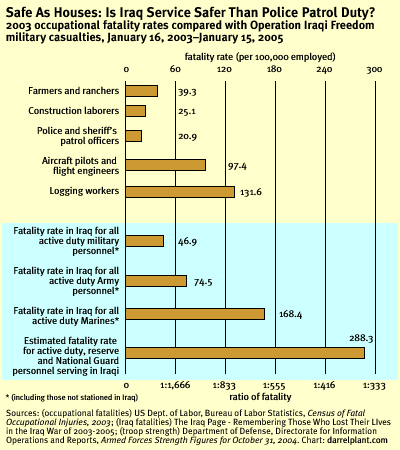
For the entire length of the Iraqi occupation, war supporters have been making the false statement that service in Iraq is safer than living in California, Washington D.C., etc. Perhaps the most well-known of these lies was Fox “News” anchor Brit Hume, who said on August 26, 2003 that “U.S. soldiers have less of a chance of dying from all causes in Iraq than citizens have of being murdered in California, which is roughly the same geographical size”. This type of “comparison”, of course, is exactly the same as that used to claim a Bush mandate in the 2004 election, by surrounding densely-populated “blue” metropolitan areas with relatively empty “red” counties. (Even Howard Kurtz pointed out his error. Hume replied: Admittedly it was a crude comparison, but it was illustrative of something.”)
Lies about fatality rates were abundant throughout that summer. All of them relied on erroneous comparisons of vastly differing population groups. In Hume’s case, though he said he was comparing two areas similar in size, the population groups (US military personnel vs. the entire population of California) were vastly different. As a Buzzflash analysis from August, 2003 pointed out, armed service personnel in Iraq were over 67 times more likely to be killed than residents of California, and that was before the major increase in insurgent attacks in 2004.
The Buzzflash piece reports an AP story showing how Donald Rumsfeld started the ball rolling in June, 2003.
“You’ve got to remember that if Washington, D.C., were the size of Baghdad, we would be having something like 215 murders a month,” Rumsfeld said. “There’s going to be violence in a big city.”
Here the problem was that Rumsfeld was comparing a fatality rate within the population of the military, but using the relative sizes of the civilian populations as the scaling factor. A true comparison would have scaled the number of personnel in Iraq (and the number of fatalities) to the size of the DC population. With math skills like that at his disposal, it’s no wonder that Rumsfeld’s bungled every move he made in the Iraq invasion.
Eager “troop supporters” followed close on Rumsfeld’s heels to show how the ‘hood they lived in was worse than Baghdad, too. Sacramento Bee columnist Daniel Weintraub wrote on June 29, 2003:
Here in the state that is famously roughly the size of Iraq, we have an average of 5 homicides a day (that would be about 300 since May 1). We also have 18 reported rapes per day, 134 robberies, 258 assaults, 395 motor vehicle thefts and 27 arsons. Match that, Mesopotamia.
And the lies just kept coming, giving many gullible people the impression that life in Iraq was just a “cakewalk” (a word that will be associated with Iraq forever, thanks to former Donald Rumsfeld aide, Ken Adelman, who wrote the infamous “Cakewalk In Iraq” op-ed in the Washington Post in February 2002). The misperception continues to this day.
Oregonian letter-writer Larry Iverson (“Service is not a death sentence”, Jan. 18) states that although he is a banker, he was unable to “coax my eight-digit calculator” to determine the fatality rate for service members in Iraq, and that he could “guarantee that the death rate is much higher for police officers, firefighters, loggers and commercial fisherman that it is for (those in) combat.” I encourage people not to put their trust in that guarantee.
According to the US Department of Labor, Bureau of Labor Statistics, the fatality rate for logging workers is 131.6 per 100,000 employed. That’s the highest death rate for any of the selected occupations in the 2003 Census of Fatal Occupational Injuries. The fatality rate for police and sheriff’s patrol officers was 20.9 per 100,000, below that of construction laborers (25.1), farmers and ranchers (39.3), and aircraft pilots and flight engineers (97.4).
According to the Department of Defense’s troop strength figures for the end of October, 2004 there were 1,475,125 active duty members of the armed services. Between January 16, 2004 and January 15, 2005, 692 active duty members of those services (not National Guard or Reserve) died in Iraq. That’s an overall fatality rate of 46.9 per 100,000. 371 of those deaths were active duty Army personnel; the Army had 498,616 troops in the report: that’s 74.5 deaths per 100,000. The Marines suffered 298 deaths from a force of 177,181 for a fatality rate of 168.4 per 100,000.
Those figures, of course, are for entire services, not the portions of the services serving in Iraq, which are more difficult to calculate because of rotations of troops in and out of country through the year. If you assume an average force level of 120,000 for last year, and a six-month average turnover (which is faster than I understand is the case), that’s 240,000 troops serving in Iraq per year. The casualty rate for those troops would be 288.3 per 100,000, more than twice as high as fatalities for loggers, nearly 14 times the rate for police, and much higher if troops don’t actually rotate out in six months.
Mr. Iverson is correct, the service isn’t a death sentence in and of itself — particularly if your duty calls you to the Pentagon — but for the two services taking the bulk of the casualties, minimizing the danger the combat troops face is disrespectful, particularly when it’s based on faulty math.